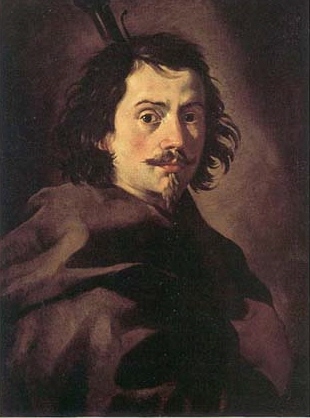
Born: 25 September 1599, Bissone (present-day Switzerland)
Died: 2 Ugust 1667 (aged 67)
Period: Baroque Architect
The Life of Francesco Borromini
Francesco Borromini, born Francesco Castelli on September 25, 1599, in Bissone, present-day Switzerland, was a pioneering architect of the Roman Baroque period. His innovative designs and masterful use of space, light, and architectural forms significantly contributed to the development of Baroque architecture, setting him apart as one of the era’s most creative minds.
Borromini’s early life in the Lake Lugano region laid the groundwork for his architectural career, but it was in Rome that his talents truly flourished. Moving to Rome in the early 17th century, he initially worked as a stone mason on several projects, including the famous St. Peter’s Basilica, under the guidance of his cousin Carlo Maderno, a leading architect of the time. This experience, coupled with his later collaboration with Gian Lorenzo Bernini, another central figure in Baroque architecture, played a crucial role in shaping his architectural vision.
Unlike many of his contemporaries, Borromini did not receive formal education in architecture; his knowledge was instead derived from hands-on experience and an intensive study of ancient Roman and Renaissance buildings. This practical background infused his work with a distinctive blend of creativity and technical prowess.
Borromini’s first major commission, the church of San Carlo alle Quattro Fontane (also known as San Carlino), marked the beginning of his solo career and showcased his innovative approach to architectural design. His work is characterized by its dynamic use of curves and counter-curves, complex geometric patterns, and the dramatic interplay of light and shadow, all of which challenged traditional architectural norms.
Some of Borromini’s other notable projects include the Oratory of Saint Phillip Neri, the church of Sant’Ivo alla Sapienza with its iconic spiral lantern, and the façade of San Giovanni in Laterano. Each of these works exhibits his signature style, which combined a deep respect for classical tradition with a bold, imaginative reinterpretation of architectural forms.
Despite his professional successes, Borromini’s life was marked by personal struggles, including intense rivalries with other architects like Bernini, and periods of depression. His temperament, perceived as melancholic and difficult, often led to conflicts with patrons and collaborators.
Borromini’s life came to a tragic end when he died by suicide on August 3, 1667, in Rome. His legacy, however, lives on through his extraordinary contributions to the field of architecture. Borromini’s work not only defined the Baroque movement in Rome but also left a lasting impact on the evolution of European architecture. His innovative spirit and the emotional depth of his designs continue to be celebrated and studied by architects and scholars around the world.
Francesco Borromini’s Notable Works
Francesco Borromini, a mastermind of Baroque architecture, left a profound impact on the architectural landscape of Rome and beyond. His innovative approach, characterized by dynamic forms, complex geometries, and a meticulous attention to detail, resulted in some of the most distinctive and influential buildings of the 17th century. Here are ten of Borromini’s most famous works, which collectively encapsulate his genius and lasting legacy in architectural history:
- San Carlo alle Quattro Fontane (San Carlino) – A masterpiece of Baroque architecture, this church is celebrated for its undulating façade and complex, spatially dynamic interior, crowned with a coffered dome that features an intricate geometric pattern.
- Sant’Ivo alla Sapienza – Known for its striking spiral lantern and concave-convex façade, this church demonstrates Borromini’s skill in blending architectural complexity with harmonious proportions. It serves as a part of the Collegio Romano and is a hallmark of Borromini’s innovative design principles.
- Oratorio dei Filippini (Oratory of Saint Phillip Neri) – Adjacent to the Church of Santa Maria in Vallicella, this oratory showcases Borromini’s mastery in creating a rhythmic facade and a functional yet aesthetically pleasing interior layout, integrating it seamlessly with the pre-existing church.
- San Giovanni in Laterano (Basilica of St. John Lateran) – Although Borromini’s contribution was part of a larger renovation, his work on the basilica’s loggia and the interior redesign is noted for its creative use of architectural elements and respect for the historical context.
- Santa Agnese in Agone – While the initial designs were not Borromini’s, his involvement in later stages added a dynamic complexity to the building’s concave façade and interior spaces, contributing significantly to its overall composition in Piazza Navona.
- Palazzo Spada – The gallery’s perspective (Galleria Prospettica) within Palazzo Spada is one of Borromini’s most ingenious creations. Using forced perspective, he created an illusion of depth, making the corridor appear much longer than it is, with a sculpture at the end that looks full-sized but is actually much smaller.
- Santa Maria dei Sette Dolori – This church and convent showcase Borromini’s skill in handling constrained urban spaces, creating a richly detailed yet compact composition.
- Sant’Andrea delle Fratte – Borromini was responsible for the design of the bell towers and the dome of this church, which are notable for their elegant proportions and innovative design.
- San Michele a Ripa Grande – His work on the façade of the elderly hospice within this complex demonstrates his ability to adapt and innovate within an existing framework, creating a strikingly balanced and harmonious façade.
- Chapel of the Three Kings (Cappella dei Re Magi) within the church of San Silvestro al Quirinale – Though a smaller work, this chapel exemplifies Borromini’s talent for creating spiritually engaging spaces through the manipulation of architectural forms and light.
Francesco Borromini’s works are emblematic of the Baroque spirit, with their emotional intensity, structural complexity, and revolutionary use of space and light. Each project reflects his persistent quest for new architectural expressions and his profound impact on the development of Baroque architecture.